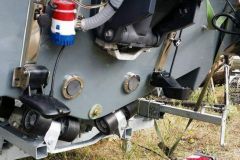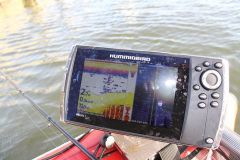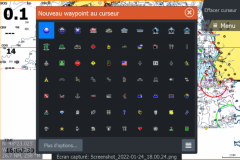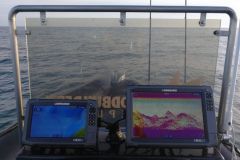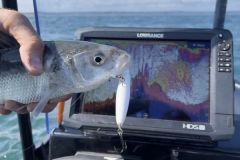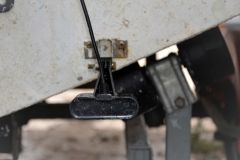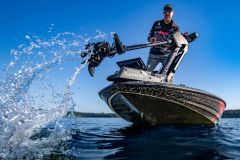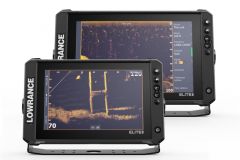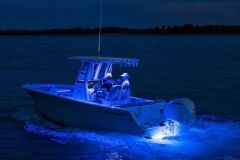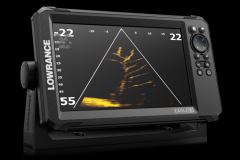For the purpose of this article, we contacted a well known sport fisherman in the French fishing landscape who has been using Garmin technologies for several years: Vincent Rollet.
Vincent Rollet's installation
- 2 ECHOMAP Ultra 12'' fishfinders
- Garmin Force with GT 54 sensor incorporated with the engine
- GT 56 sensor positioned on the transom
- Panoptix LiveScope LVS32 probe connected to a Black Box GLS 10 sounder
- Black Box MS-DB100 + Garmin Fusion speakers
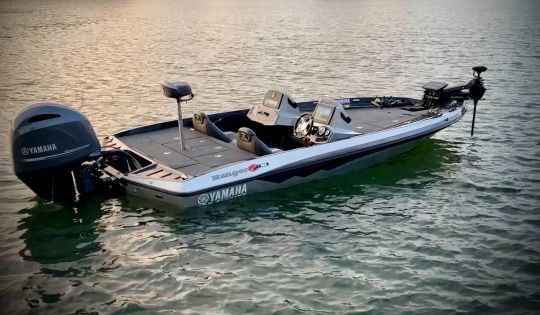
Vincent, let's start with the Garmin Force. What are the advantages of using this front electric motor?
Vincent Rollet âeuros The advantages are multiple, starting with the possibility of supplying it with 24 or 36 Volts without changing anything, it is the motor that manages its voltage by itself. I am also equipped with a 36V lithium battery which allows me to have a large capacity in energy with a very small footprint. The motor develops 80 lbs under 24 V and passes the 100 lbs under 36 V. Having so much power is really pleasant, especially in configurations where navigation with a combustion engine is forbidden. Without paying particular attention to this, the Garmin Force pulls my boat up to a speed of over 7 km/h which is really fast for an electric motor! Another useful detail is that when you turn the motor, it will automatically turn in the right direction to be stowed, no need to turn the shaft so that the propeller and the head are on the right side. You just have to select in the motor parameters the side where you want the propeller to be stored.

The Garmin Force is controllable via a pedal and a remote control, can you tell us 2 words about the latter?
Vincent Rollet âeuros From a purely practical point of view, I find the remote control very pleasant to use. It is not too big, offers a complete and very readable feedback display (engine on/off, speed engaged, heading selection, governor selection, degree of heading change...) and it floats!
One aspect of the remote control that may take some getting used to is the fact that direction changes can be made via the arrows on the remote control. One press is equivalent to 1 degree! The idea is to keep pressing the button to significantly change the orientation of the motor. A point that may surprise at first, but which ultimately offers great precision in navigation.
Moreover, it is possible to choose the orientation of the motor directly by pointing the remote control, no need to press the left or right arrows, the motor will follow the direction pointed by the remote!
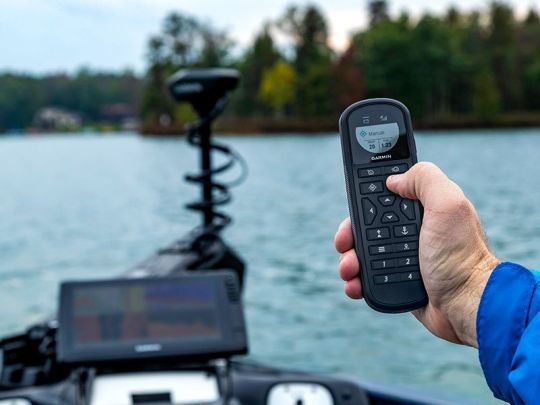
It is of course possible to connect the various on-board devices together. How is the link made between your screens, ECHOMAP Ultra, and your engine?
Vincent Rollet âeuros Very simply in Bluetooth, no need to equip yourself with additional software for the connection between engine and screen. It is possible to control the engine by touch from the screen and to draw a route to follow. You can mark several WayPoints on the screen to create a drift and make it do for example.
You use two different sensors on your boat, the GT 54, integrated in the Garmin Force and the GT 56, fixed on your transom and connected to your 2nd ECHOMAP Ultra. Is there a reason for this?
Vincent Rollet âeuros The GT 54 probe was the first probe associated with devices when Garmin introduced products associated with "Mega" frequencies, i.e., above 1000 kHz. This type of probe offers finer beams, narrower cones of detection and very precise offering a very high quality of information. The GT 54 probe is therefore more "deep sea" oriented and will be ideal for use in the sea or in lakes.
The GT 56 is a probe that has been developed to be complementary to the GT 54. It offers a wider beam, but with a lower quality of information than the GT 54. It is typically an ideal transducer for freshwater anglers who fish by sight with a fishfinder (catfish and pikeperch in the vertical).
The lower transmission frequencies of the GT 56 probe allow for wider coverage and also offer SideVü and DownVü frequencies.

So you have 2 probes for 2 different uses?
Vincent Rollet âeuros In a way yes, for more performance on each approach. On the other hand, if we do not enter the particular case of vertical fishing for catfish and pike perch with a high requirement in terms of detection, it should be noted that Garmin products are originally capable of detecting in a very efficient way up to 150 m depth. The idea is that a combined sounder can be used both by a float tube fisherman in freshwater or by a lure fisherman at sea.

Through its ActiveCaptain application, Garmin offers its customers/users free access to the latest product updates. How does this work for your equipment?
Vincent Rollet âeuros It's really simple and intuitive. You have to download the ActiveCaptain application on your smartphone and register your devices. The application detects the devices and notifies you when a new update is available. It's as simple as that.
You download the update to your smartphone using your home WiFi and as soon as your phone connects to your devices on your boat, it will automatically launch the update to the engine and fishfinders.
This system has solved some problems, including anchoring issues that some customers were complaining about on the 2nd version of the engine. The update via the platform solved the problem instantly.
In addition, a recent update has allowed the integration of new color palettes, especially for the SideVü and DownVü. This is interesting because there is no longer only shading, the different colors allow to identify densities, which allows to differentiate a boulder from a sand pile for example. These new color palettes make the information even more precise and allow to optimize even more the time of prospecting for example, no need to pass several times to the same place to get a precise idea. This saves a lot of time in large environments.
Finally, can you present the famous Panoptix Livescope and give the readers of Fishing.news some feedback on your use of it?
Vincent Rollet âeuros Already, this Panoptix LiveScope probe can be easily installed on the base of the Garmin Force electric motor thanks to the adapter supplied with it that screws around the shaft.
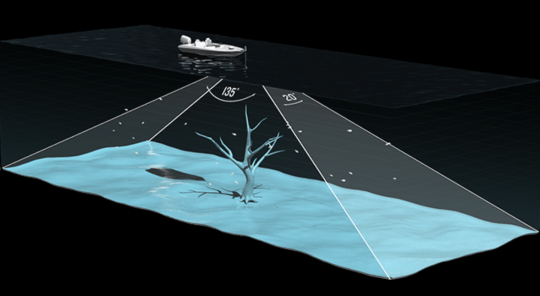
This probe has 3 different modes: Down (scanning in line with the boat and 8m in front and behind) which allows to know precisely what is happening under the boat, Forward (sweep in front of the boat, in its extension)

and Perspective (120° wide sweep in front of you), a great tool for powerfishing.
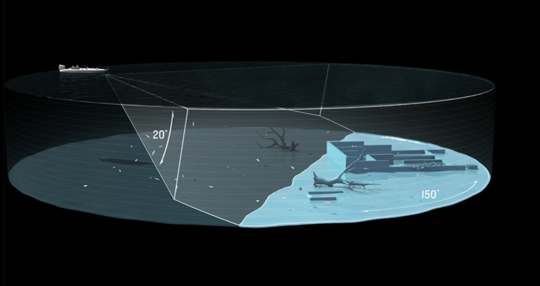
The Panoptix LiveScope allows you to capture live behavior, which is impossible to do with a conventional probe. A technology that allows you to visualize with great precision the position of a fish that you arrive on, for example, and to be able to predict with some confidence if it is willing to bite or not, or to follow pelagic fish, to see the fish arrive 20 m in front of the boat, to know if they are interested or not in the lure that is presented ... Knowing if you are tracking fish is information that you don't always have when fishing. Having this information at all times allows you to adjust your fishing quickly. In short, optimization and reading pleasure, two words I would gladly associate with the use of the Panoptix LiveScope.





